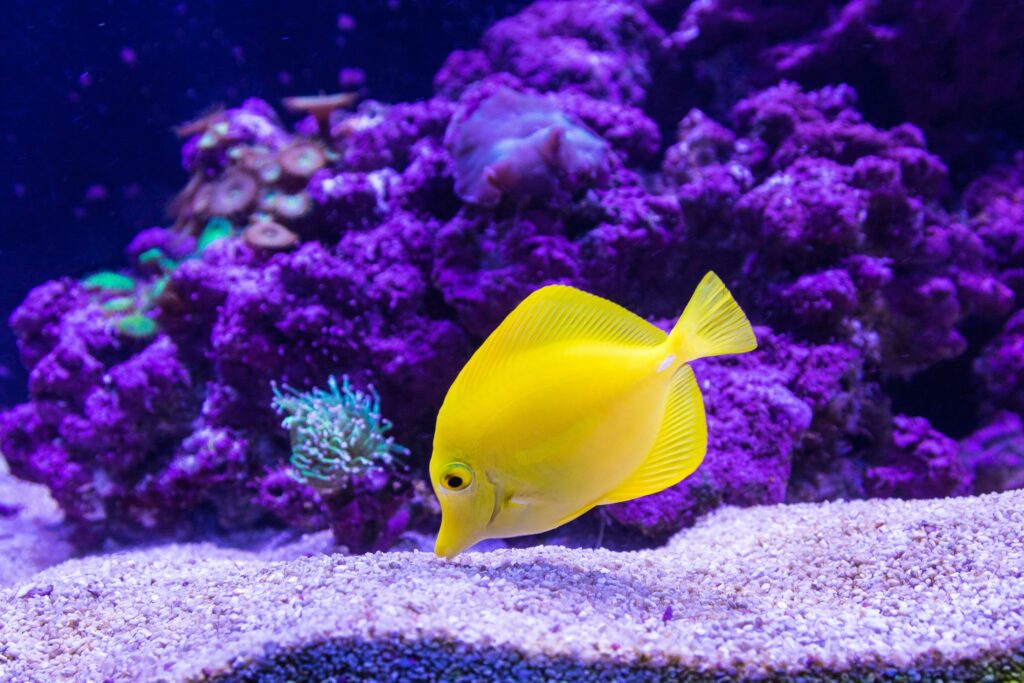Chalice Coral: A Comprehensive Guide for Beginners
Corals are not just beautiful creatures that add color to an underwater world, but they also play a vital role...
Jim Sabellico
March 18, 2022

Maintaining a reef tank is a big responsibility. Not only do you have to make sure that the fish and coral are healthy, but you also have to keep the sand clean. This can be a difficult task, especially if you don’t know how to do it properly. In this article, we will discuss how to keep your sand clean in a reef tank. We will go over the best methods for cleaning your sand and preventing algae from growing on it.
Why Do We Need Sand In A Reef Tank
Have you ever wondered what sand is made of and why we need it in a reef tank? Sand is made up of tiny bits of shells, rocks, and other marine debris. It’s an important part of a healthy coral reef ecosystem, providing both structure and shelter for many different species of fish, invertebrates, and algae. Without sand, a reef tank would not be complete.
Reef tanks are typically filled with fish coral, and as everyone knows, fish and coral need healthy water to thrive. Sand provides a substrate for the beneficial bacteria in your tank to grow, and it also helps to stabilize pH levels and provide food sources for the fish and other inhabitants of the tank.
Choosing The Right Sand For Your Reef Tank
No matter what kind of reef tank you have, you will need to use sand as part of the substrate. The type of sand that you choose is important, as it can affect the reef tank environment in a number of ways. It can be hard to find the right sand for your reef tank. With so many options on the market, it’s difficult to know which one will be best for your fish and coral. Here are a few tips to help you make the right decision:
Reef tank owners should keep in mind that not all sands are created equal and should take into account certain factors when choosing sand for their tanks. The three most important factors to consider when selecting sand are grain size, composition, and color. Plus, make sure that the sand you choose will match your specific needs and preferences.
Sandstorm Prevention Tips
Reef tanks are beautiful to look at, but they can also be a little more complicated to care for than a regular fish tank. One important thing to remember when caring for your reef tank is how to deal with sandstorms.
Sandstorms can be caused by a number of things, such as strong currents or wavemaker placement. They can cause a lot of damage to your tank and its inhabitants, so it’s important to take steps to prevent them.
One way to help prevent sandstorms is to make sure your water levels are always consistent. If you have an overflow system, make sure the flow is slow enough that it won’t create too strong currents. Here are a few tips and preventative measures against sandstorms to help you out in order to keep your reef tank healthy and thriving:
Keeping your tank clean and free of detritus is one of the best ways to prevent sandstorms. Make sure to siphon out any uneaten food or debris on a regular basis, and give your tank a good cleaning every few months. If you do start to see a sandstorm brewing, take action quickly to avoid damage to your corals and other inhabitants. By following these simple tips, you can help keep your reef tank looking great and running smoothly.
How To Clean Sand In A Reef Tank
Cleaning the sand in a reef tank can be a daunting task. Not only do you have to worry about removing all the detritus and organic material, but you also need to make sure that the sand is clean and free of toxins.
Equipment That You Need To Clean The Sand
When it comes to keeping a reef tank, cleaning the sand is essential. You’ll need some basic equipment to get the job done. Here is the list of the equipment and how they are used to keep the sand clean:
A siphon pump can help remove water and detritus from the tank. You’ll also need a gravel vacuum to clean the substrate, and a bucket will come in handy for collecting the dirty water and detritus you siphon out. Finally, cleaning pads or brushes can help scrub away stubborn algae growing between the sand and glass.
It’s important to understand the equipment you’ll need to clean sand. Not only will this help keep your tank healthy, but it will also make your fish and coral happier and look better.
How To Siphon The Sand
If you want to siphon the sand in a reef tank, there are a few things you need to know. First, you’ll need an appropriate length of tubing – at least twice the height of your tank. You’ll also need an air pump and aquarium airline tubing.
To siphon the sand, start by placing one end of the tubing in the water and the other end in a container on the floor. Turn on the air pump and allow it to run for a few minutes to create suction. Then place the tube into the sand bed and wait for it to fill up with sand. When it’s full, remove the tube from the tank and dump out the sand into a bucket or other container.
Remember to take things slowly and be gentle when stirring up the sand – it’s important not to damage any of the delicate organisms that call your tank home.
How To Remove Detritus From The Sand
Detritus is organic matter that decays and can release toxins into the water. While there are many ways to remove detritus from your reef tank, one of the most effective methods is to use a powerhead with a sponge filter. Powerheads provide powerful circulation in your reef tank, which helps to break up and remove detritus. Additionally, using a powerhead with a sponge filter will also help to keep your water quality high and maintain good water flow in your reef tank.
There is also another way of removing detritus from the sand in a reef tank. First, be sure to use a gentle current to avoid stirring up the sand and causing more dust to rise. You can use a powerhead or an airstone placed at one end of the tank to create a gentle flow.
As we have seen, there are a few ways to clean detritus from the sand in a reef tank. Each has its own advantages and disadvantages. The best way to find out which method works best for you is to try them all out and see what gives you the best results
The Benefits Of Keeping The Sand Clean
Keeping your sand clean is one of the most important things you can do to maintain a healthy reef tank. Sand is essential for stabilizing the ecosystem, and if it becomes dirty or clogged with algae, it can disrupt the entire tank. Sand also acts as a natural filter for aquariums, and when it’s dirty, it can lead to poor water quality and an increase in algae growth. This can not only be unattractive, but it can also be harmful to your fish.
Cleaning your sand regularly will help keep your reef tank looking great and functioning properly. Make sure you use a good filter or sieve to remove any large pieces of debris and siphon off any sediment that has built up at the bottom of the tank. By regularly cleaning your sand bed, you can help to ensure that your aquarium is running at its best.
Tips For Keeping The Sand Clean
One important factor for keeping a reef tank healthy is to maintain clean sand. When the sand becomes dirty, it can lead to decreased water quality and health problems for the fish and other creatures that call the tank home.
There are several ways to keep your sand clean, but one of the most common methods is by using a powerhead to stir up the bottom of the tank. This helps move debris and waste particles out of the sand and into the water column where they can be more easily filtered. It’s also important to perform regular water changes on your reef tank, as this will help remove any built-up toxins or pollutants in the water. Not only does this look nice, but it also helps keep your fish and other creatures healthy. Here are another few tips for keeping your sand clean!
Keeping your sand clean is an important part of reef tank maintenance. If you don’t keep your sand clean, it can lead to a number of problems for your tank inhabitants. By following these simple tips, you should be able to maintain a beautiful and healthy reef tank with minimal effort.
To Finish
Keeping sand clean in a reef tank is not as difficult as it may seem. By following a few simple steps and using the proper equipment, you can keep your tank looking great and your fish healthy. We hope you have found this article helpful and that it has given you the information you need to properly care for your reef tank.
Related article: How to Reduce Nitrates in a Saltwater Aquarium: Effective Methods

I am the founder of J. Louis, a digital marketing agency focused on providing innovative solutions and strategies built on a foundation of creative design and technology. A family man who loves travel and reef tanks, I’ve been coined as a jack of all trades, master of a few of them, most specifically website and sales funnel design, monetization and growth strategies, and viral marketing. I began pursuing my passions for business by cutting my neighbor’s lawns when I was just 8 years old and never looked back. Over the past 20 years, I have amassed significant experience providing consulting, design and development services for Fortune 500 companies, government, retail, private individuals, and A-list celebrities.
Corals are not just beautiful creatures that add color to an underwater world, but they also play a vital role...
As we move into the new year, it's time to start thinking about what reef tank LED lighting kits will...

Proceeds from all purchases go directly to Great Barrier Reef Foundation and supporting their mission.
Want to stay connected with all the latest news in the Reef Tank Addict community? Drop your email below!
Proudly Supporting The Great Barrier Reef Foundation
Copyright © 2023. All rights reserved.